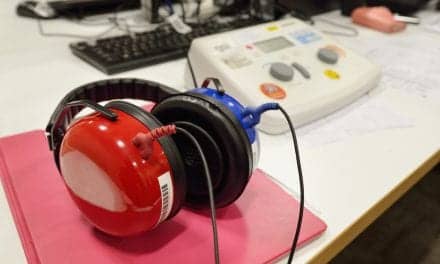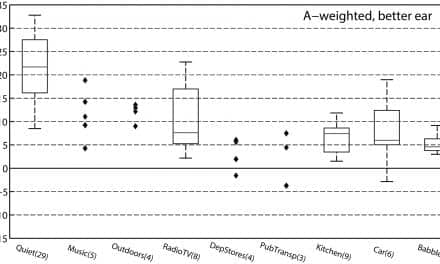Research | March 2016 Hearing Review
Gauging listening difficulties experienced by working-age adults with normal audiograms
The results of this study suggest that younger working adults (under age 60) with normal audiograms may have more self-reported difficulty with communication in common listening situations than most clinicians would expect. Many of the individuals reporting problems in specific listening situations may benefit from situational remediation. Hearing care professionals would be wise to intervene in the care and management of younger working-age adults, many of whom are just beginning to experience a decline in their communication ability in ordinary listening situations. In this light, the PACA may emerge as a useful tool in assessing the needs of this population.
It is relatively common for clinicians to encounter patients with modest, sometimes vague complaints about an inability to hear in a variety of everyday listening situations. In these scenarios, inexperienced clinicians, in particular, begin to assume (usually during the case history) that patients reporting these types of communication problems have a hearing loss. On the other hand, most experienced clinicians have learned that numerous complaints about hearing and communication do not always equate to abnormal hearing. These cases are frequently a quandary for clinicians because the patient reports communication problems, but the test results show no indication of a condition that warrants treatment. Survey data suggests 43% of patients with milder losses are given a “wait and re-test” approach.1
Research does indicate that audiometric test results do not always provide information about difficulties experienced by an individual in real life situations.2,3 Further, Tremblay et al4 used a population approach to identify the prevalence and risk factors associated with self-reported hearing difficulties among people who have normal audiometric evaluations. The authors determined that 12.0% of individuals with normal audiometric thresholds had self-reported hearing difficulty, resulting in an overall prevalence of 2.9%. These findings highlight that even people with normal or mild hearing losses may have difficulties in various listening environments.
Given the relatively high occurrence of self-reported hearing difficulty accompanying normal or near-normal hearing, combined with a general sense that hearing test results are not always consistent with communication difficulties expressed by many patients, further study into this area is needed.5,6 Moreover, according to the International Classification of Functioning, Disability and Health, also known as the ICF,7 various functional domains (eg, body structure, body function, environmental, and personal factors) play an important role in determining day-to-day activities of the individual. This model may explain why those with normal body structure and function may also experience problems in challenging environments. Hence, they may need some assistance in listening and/or communication in those listening environments.
Self-reported measures are an important part of clinical management, as they can provide “patient-perspective” during the assessment and management of chronic conditions.8 Comprehensive assessment of communication difficulties and/or needs in different situations are important when developing an appropriate management plan.

Figure 1. Example of the completed Personal Assessment of Communication Abilities (PACA) questionnaire.
Recently, Clutterbuck9 developed a new assessment tool, “Their Reported Assessment of Communication Abilities” or TRACA, which focuses on self-assessment of communication difficulty of individuals in a variety of common listening settings. This self-report includes 12-items believed to be among the most common listening situations where communication breakdowns occur, regardless of age, gender, or socioeconomic standing.
The TRACA was renamed the Personal Assessment of Communication Abilities (PACA). It is intended to be administered during the initial audiological assessment in order to gauge the patient’s perception of communication difficulties in common listening situations. Figure 1 provides an example of a completed PACA questionnaire.
Study Method
Data using the Personal Assessment of Communication Abilities (PACA) was collected from 143 participants at an audiology clinic in Victoria, Australia. All participants visited the clinic as part of a mandatory baseline physical for industrial workers, or were referred by their physician who needed to determine the possible hearing loss wasn’t associated with some other medical condition. Because the testing was conducted as part of a mandatory baseline physical for workers, very few older adults were part of the sample; only 14 participants were over age 60. For this reason, data collected on the PACA is believed to be representative of communication difficulties for active working adults, the majority of whom are younger than the average hearing aid user.
Only patients with normal hearing were included in this analysis of PACA data. All participants had hearing thresholds 20 dBHL or better between 0.25-8kHz. All participants had good mental, visual, and literacy status (ie, they were able to complete the PACA without assistance). Table 1 shows the age and gender spread of the participants.
Age / Gender |
Males |
Females |
Gender not known |
| 20-29 years (N=19) | 9 | 9 | 1 |
| 30-39 years (N=31) | 12 | 18 | 2 |
| 40-49 years (N=42) | 19 | 22 | 1 |
| 50-59 years (N=37) | 10 | 24 | 3 |
| 60-69 years (N=14) | 7 | 6 | 1 |
Results

Figure 2. Communication difficulties experienced (in %) by individuals with normal audiogram as indicated in the Personal Assessment of Communication Abilities (PACA) scale. The five age groups are represented by the colored bars, as noted on the bottom of the figure. (Click on image to view larger size.)
Figure 2 shows the ratings of 143 individuals with normal audiometric thresholds. It represents their self-reported communication difficulties recorded on the PACA questionnaire, using a 1-5 Likert scale. The results suggest that the majority of normal-hearing individuals face some degree of self-reported difficulty in several listening environments.
According to the PACA data collected during the initial assessment, the most challenging listening situations are:
- Large groups;
- Small groups;
- Restaurants/cafes, and
- The workplace.
Approximately 20% of the participants reported a moderate amount of communication difficulty in these four situations. Further, about another 40% of participants reported a slight amount of difficulty in these four common listening situations. Taken together, more than 60% of the participants, all with normal audiograms had some degree of self-reported communication difficulty.
With the exception of the youngest age group, 20-29 year olds, participant’s age does not appear to be linked to self-reported difficulty, as the general pattern of results indicates that all four groups over age 29 had similar degrees of self-reported difficulty. For example, large group and restaurant/cafe listening seems to be the most challenging area where communication difficulties occur, as it had the largest number of participants reporting “moderate” and “quite a lot of” difficulty. For these two listening situations, more than one-quarter of the three groups over age 30 reported a moderate or worse degree of difficulty for listening in large groups and restaurants/cafes.
Upon closer inspection, five of the common listening situations assessed with the PACA—workplace, small groups, mobile phones, watching TV, and riding/driving in the car—yielded a self-report of moderate or worse from 20% or more of the respondents older than 30 years of age. This finding suggests that a substantial number of adults of working age have some degree of self-reported difficulty in common listening conditions.
Key Findings and Discussion
Figure 2 shows preliminary crude normative data for a new self-reported measure (ie, PACA) of communication in common, everyday listening situations. Our results indicate many individuals with normal audiometric patterns have difficulty in several common listening environments (eg, large groups, restaurants/cafes).
This finding is in agreement with several studies which also show that hearing difficulties are more substantial than the pure-tone audiogram would suggest.2,3 Many individuals with a slight hearing loss of up to 25dB HL experience activity limitations and participation restrictions.10 In a study by Chai et al,11 51% of adults ages 48 years and older reported hearing difficulties, and approximately one-half of this group had normal audiograms. In another recent study by Hannula et al,12 60% of adults between ages 54 and 66 self-reported difficulty following conversations in noise, particularly with the television and in restaurants. More recently, Tremblay et al4 determined that 12% of adults between the ages of 21 and 84 years have hearing difficulties accompanying a normal audiogram.
Our data suggests that 20-29 year olds had minimal self-reported difficulty for 9 of the 12 items listed on the PACA. For large groups, restaurants/cafes, and television, approximately 20% to 30% of respondents in the youngest category of age had some self-reported difficulty. This self-reported difficulty in these three listening situations was most likely to be recorded as “slight” on the 1 to 5 Likert scale of the PACA.
For three of the age categories (study participants between ages 30 and 59 years), approximately 40% of respondents reported some amount of difficulty on all items of the PACA with one exception: one-on-one communication. The most challenging listening situations, based on this self-report data, tend to be large groups, restaurants/cafes, small groups, workplace, mobile phones, and television.
These results suggest that younger working adults (younger than age 60) with normal audiograms may have more self-reported difficulty with communication in common listening situations than many clinicians expect. A proportion of these individuals may have had some auditory abnormalities, which are not identified by the audiogram (eg, central auditory processing difficulties). However, it is likely the population included few with such abnormalities. Hence, a better appreciation for acoustics when designing rooms and buildings is necessary. In addition, there is also need for developing appropriate listening devices that may facilitate listening in some situations (eg, television). Efforts should be made to develop vocational enablement programs to address the individual communication needs.13
Although self-reports of communication difficulty do not necessarily equate to a willingness on the part of the individual to seek improvement in these listening environments, it is believed that many of the individuals reporting problems in specific listening situations can benefit from situational remediation. For example, new ear-worn amplification technology (hearables) paired to a remote companion microphone may be a viable solution for those struggling with group listening, particularly in background noise. Additionally, there is emerging technology that could be beneficial to patients with normal audiograms and self-reported difficulties in specific listening situations, including a variety of customizable Bluetooth telephone amplifiers, directed audio devices for television viewing, and smartphone amplification apps. Hearing care professionals would be wise to intervene in the care and management of younger, working-age adults—many of whom according to this study are just beginning to experience a decline in their communication ability in ordinary listening situations.
In the near future products designed to enhance daily functional communication for individuals with normal audiograms and complaints of highly situational communication deficits—a type of patient that hearing care professionals are not accustomed to seeing—may be prescribed. Overall, as the self-reported hearing difficulties are more common than actual measured hearing impairment, it is important to approach this from a public health perspective.
The PACA questionnaire can be useful in clinical settings when exploring communication difficulties and the unique needs of working-age adults. We suggest that the current study findings can be used as a baseline while using the PACA in a clinical population. However, work remains to carefully study the psychometric properties (ie, construct validity, concurrent validity, predictive validity, test-retest reliability and also internal consistency) of this self-reported measure. Current study results must be considered tentative, and more careful observation of both on individuals with normal and abnormal audiometric patterns are needed.
References
-
Kochkin S. MarkeTrak VIII: The key influencing factors in hearing aid purchase intent. Hearing Review. 2012;19(03):12-25. https://hearingreview.com/2012/03/marketrak-viii-the-key-influencing-factors-in-hearing-aid-purchase-intent
-
Manchaiah VKC, Freeman B. Audiogram: Is there a need for change in the approach to categorise degree/severity of hearing loss? Int J Audiol. 2011;50:638-640.
-
Manchaiah VKC, Stephens D. Perspectives in defining ‘hearing loss’ and its consequences. Hearing, Balance and Communication. 2013;11(1):6-16.
-
Tremblay KL, Pinto A, Fischer ME, Klein BEK, Klein R, Levy S, Tweed TS, Cruickshanks KJ. Self-reported hearing difficulties among adults with normal audiograms: The Beaver Dam Offspring study. Ear Hear. 2015;36(6):e290-299.
-
Timmer BHB, Hickson L, Launer S. Adults with mild hearing impairment: Are we meeting the challenge? Int J Audiol. 2015;54(11):786-795.
-
Timmer B. It may be mild, slight, or minimal, but it’s not insignificant. Hearing Review. 2014;21(4):30-33. Available at: https://hearingreview.com/2014/04/may-mild-slight-minimal-insignificant
-
World Health Organization (WHO). International Classification of Functioning, Disability and Health (ICF). Geneva, Switzerland: WHO;2001.
-
Taylor B. Self-Report sssessment of hearing aid outcome–An overview. Audiology Online. 2007. Available at: http://www.audiologyonline.com/articles/self-report-assessment-hearing-aid-931
-
Clutterbuck S. Another tool for assessment of communication needs? Try the TRACA: Their Reported Assessment of Communication Abilities. Audiology Practice. 2015;7(1):16-19.
-
Bess FH, Lichtenstein MJ, Logan SA. Making hearing impairment functionally relevant: Linkages with hearing disability and handicap. Acta Otolaryngol. 1991;111:226-231.
-
Chia EM, Wang JJ, Rochtchina E, Cumming RR, Newall P, et al. Hearing impairment and health-related quality of life: The Blue Mountains Hearing Study. Ear Hear. 2007;28:187-195.
-
Hannula et al. Self-Reported Hearing Problems among Older Adults: Prevalence and Comparison to Measured Hearing Impairment. J Am Acad of Audiol. 2015;22(8):550-559.
-
Kramer SE. Hearing impairment, work, and vocational enablement. Int J Audiol. 2008, 47(Suppl. 2):S124-130.
Brian Taylor, AuD, is senior director of clinical affairs at Turtle Beach Corp, San Diego, and serves as a clinical advisor for Fuel Medical Group in Portland, Ore.
Vinaya Manchaiah, AuD, is director of audiology in the Department of Speech and Hearing Sciences at Lamar University in Beaumont, Tex, serves on the Board of Directors for Audiology India, and also works with the Swedish Institute for Disability Research at Linköping University.
Susan Clutterbuck, BSc (Hon), is an audiologist and the co-founder of EarTrak, Victoria, Australia, as well as the past owner/manager of a multi-office private practice in Australia.
Correspondence can be addressed to HR or Dr Taylor at: [email protected]
Original citation for this article: Taylor B, Manchaiah V, Clutterbuck S. Using the Personal Assessment of Communication Abilities (PACA) Tool. Hearing Review. 2016;23(3):20.?








EARtrak is pleased to make this tool available free of charge. Visit http://www.eartrak.com/paca where you can register to have the PACA prefit tool sent to you.